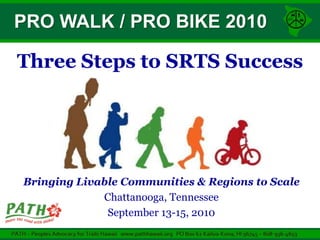PATH - Three Steps to SRTS Success
- 1. PRO WALK / PRO BIKE 2010 Three Steps to SRTS Success Bringing Livable Communities & Regions to Scale Chattanooga, Tennessee September 13-15, 2010
- 2. Three Steps to Success A Model to ACCELERATE SRTS ŌĆó Achieving ŌĆó Comprehensive ŌĆó Cost-Effective ŌĆó Long lasting ŌĆó Evaluative ŌĆó Replicable ŌĆó Accountable ŌĆó Time-bound ŌĆó Equitable ŌĆ”SRTS Programs
- 3. Three Steps to Success The Three Step Model is intended for: ŌĆó Advocacy organizations or other groups who are working with multiple communities ŌĆó Under-resourced school leaders who are unsure of where or how to start ŌĆó Informed, well-intentioned but overwhelmed champion(s)
- 4. Three Steps to Success The Three Step Model aims to: ŌĆó Build on existing online toolkits & resources, not duplicate ŌĆó Provide a comprehensive SRTS program that is scalable and also unique to each community ŌĆó Emphasize evaluation & sustainability
- 5. Step 1: Form a Team
- 6. Step 1: Form a Team Understand SRTS ŌĆó www.saferoutespartnership.org ŌĆó www.saferoutesinfo.org ŌĆó State DOT SRTS Coordinator ŌĆó State Network Organizer
- 7. Step 1: Form a Team Recruit Team Members ŌĆó Find an existing group, i.e. PTA ’é¦ Form a subcommittee or task force ŌĆó Form a small, committed stand-alone group ŌĆó Help the team understand SRTS
- 8. Step 1: Form a Team Host a Kick-Off Team Meeting ŌĆó A fun, productive small group strategic discussion about starting a SRTS program ŌĆó Purpose: ŌĆó To get clear on Safe Routes to School and the three steps to success process ŌĆó To plan for Step 2: Evaluation Activities
- 10. Step 2: Evaluation Prepare Evaluation Activities ŌĆó Parent/Caregiver Survey ŌĆó Distribution ŌĆó Collection ŌĆó Data Entry ŌĆó Student Travel Tally ŌĆó Scheduling Tallies ŌĆó Coordination with Teachers
- 11. Step 2: Evaluation Prepare Evaluation Activities (Optional) ŌĆó Traffic Count / Safety Observation ŌĆó Set Date, Time ŌĆó Recruit volunteers ŌĆó Walk About / Walk Audit ŌĆó Set Date, Time, Route ŌĆó Recruit participants
- 12. Step 2: Evaluation Implement Evaluation Week Monday Tuesday Wednesday Thursday Friday Parent AM Traffic Collect Surveys sent Count, Safety completed home with Observation surveys students (expect more Student Student Student to come in Travel Tally Travel Tally Travel Tally future days) PM Traffic After School Count, Safety Walk Audit Observation
- 13. Step 2: Evaluate Complete the Evaluation ŌĆ£Report CardŌĆØ ŌĆó Collect all evaluation forms ŌĆó Parent Survey, Tallies, Audit Forms ŌĆó Submit Information to NCSRTS ŌĆó Write up Evaluation Report Card ŌĆó How students get to and from school ŌĆó School safety zone info & route
- 14. Step 3: Plan & Action
- 15. Step 3: Plan & Action Host the SRTS Town Hall Meeting ŌĆó A fun, productive large group meeting bringing school & community together ŌĆó Purpose ŌĆó To introduce SRTS to a broad audience ŌĆó To present the schoolŌĆÖs evaluation results ŌĆó To build support and capacity for SRTS ŌĆó To identify SRTS solutions
- 16. Step 3: Plan & Action Town Hall: Present Evaluation Report
- 17. Step 3: Plan & Action Town Hall: ŌĆ£SRTS 101ŌĆØ Speed Dating
- 18. Step 3: Plan & Action Town Hall: Solutions Exercise ŌĆó A fun, interactive exercise for everyone in attendance ŌĆó Purpose 1. Builds interest 2. Recruit SRTS Team 3. Hear from local residents
- 19. Step 3: Plan & Action Compile the SRTS Plan ŌĆó SRTS Team Planning Meeting ŌĆó Vet solutions from the Town Hall ŌĆó Identify a vision for the program ŌĆó Write up the Plan ŌĆó School profile ŌĆó Our Vision ŌĆó Evaluation Report Card ŌĆó Our Solutions & Next Steps
- 20. Step 3: Plan & Action Take Action!
- 23. Review: Three Steps to Success
- 24. Applying the Three-Step Model HOŌĆÖ─ĆLA: HawaiiŌĆÖs Opportunity for Active Living Advancement HoŌĆÖ─üla means ŌĆ£To AwakenŌĆØ in Hawaiian.
- 25. Applying the Three-Step Model About the HOŌĆÖ─ĆLA Project ŌĆó Funded by the Robert Wood Johnson Foundation Active Living Research Program ŌĆó 14 Schools in Hawaii County ’āś All serve low-income Communities (>50% FRL) ’āś 9 Active Schools ’āś 5 Comparison Schools
- 26. Applying the Three-Step Model Waikoloa Elementary School o Step 1: Form a Team ’āś Consisted of the PCNC, School Counselor, PATH Team Leader o Step 2: Evaluation ’āś Parent Surveys, Traffic Counts, Safety Observations & Tallies o Step 3: Plan & Action ’āś Town Hall: Held at Family Fun Night ’āś Planning Meeting: Team tripled in size ’āś Program Consists of: Walking School Bus, Bicycle and Pedestrian Education
- 27. Applying the Three-Step Model Waimea Elementary School o Step 1: Form a Team ’āś A project of the existing School Community Council o Step 2: Evaluation ’āś Parent Surveys, Traffic Counts, Safety Observations & Tallies o Step 3: Plan & Action ’āś Town Hall: Held at Family Movie Night ’āś Planning: Added librarian, PATH members ’āś Program Consists of: Walking School Bus, Bike & Ped Ed, a major sidewalk project with Federal SRTS funds ($382,000)
- 28. Applying the Three-Step Model Pa`auilo Elementary School o Step 1: Form a Team ’āś Brand new group headed by Principal, teachers, parents & PATH Team Leader o Step 2: Evaluation ’āś Parent Surveys, Traffic Counts, Safety Observations & Tallies o Step 3: Plan & Action ’āś Town Hall: Held at PTSA Meeting ’āś Planning: Added counselor, 3 teachers ’āś Program Consists of: Signage, New Trail Bike & Ped Ed, Walk to School Day
- 29. Thank You Laura Dierenfield Executive Director - PATH Peoples Advocacy for Trails Hawaii Email: laura@pathhawaii.org Phone: 808-326-PATH (7284) Please contact me if youŌĆÖd like to learn more about the Toolkit and the Three Step Model.




























